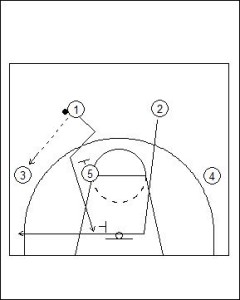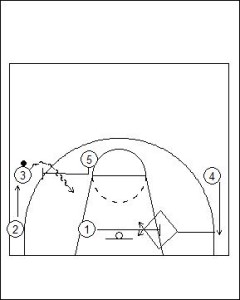UCLA Offense: Strong Side Overload with On-Ball
The UCLA Offense is a staple for many coaches when selecting a tried and proven offensive strategy. There are few offensive philosophies that have had such rigorous testing and retesting as the UCLA Offense.
The Strong Side Overload with On-Ball Play is a specially designed to provide a wide range of scoring opportunities with a variety of different actions to confuse and put the defence on the back foot. A A Feature of the play is the quick and succinct movements towards the basket and a very short time line for the offense to occur.

The UCLA Offense is very effective at drawing players away from the basket. This is a key feature of the 4 out and 1 in formation which brings strong defensive players away from the basket, especially shot blockers.
The first movement is the traditional UCLA Cut. One (1) makes a pass to the wing player (Three). One (1) then creates a lead before moving off the screen set from Five (5) and cutting to the basket.
As one (1) reaches the double block, Two (2) should initiate a cut to the weak side of the backboard. This should be a sprint, a foot race between the offensive and defensive player.
Once reaching the position at weak side of the backboard, Two (2) then moves to the strong side long corner.
Point of Emphasis
- It is often overlooked as a scoring threat, but the initial UCLA Cut is a very effective movement at allowing players to become free and be in a scoring position. As a coach make sure you communicate the possibilities of this early opportunity in the offense.
- Two (2) is a scoring threat even though there is no screen or additional action to impede the defensive players movement. Most defensive players will be reactive, rather than proactive in this position and not move until well after the initial cut by the offensive player.
- Two (2) will then initially be screened by One (1) and be free as the player moves to the long corner. Two (2) will then be free for a pass to the long corner to take an open three-point shot.

One (1) moves to set a Flex Screen on the weak side of the floor. The further One (1) can move the defensive player across the split line the better.
Five (5) makes a movement to the basket and the breaks at the foul line to set an on-ball screen for Three (3).
Three (3) uses the on-ball screen to get into the keyway. Three (3) is not looking to lay the ball up, but rather finish their movement at the broken circle as either a jump-stop and jump shot or jump-stop and assist to Five (5) or Four (4).
Four (4) should look to time the cut to the basket to be coming over the shoulders of One (1) as the Three (3) clears the on-ball screen set by Five (5).
Four (4) can either go over or under the screen set by One (1) depending on the positioning of the defensive player.
Two (2) looks to lift up the side line to replace Three (3) into the players initial position. Two (2) in this position will be a pressure release pass. From this point Two (2) can either take the three-point shot or pass to Five (5) on the deep interior seal after rolling from the on-ball screen.
Scoring Options:
- Three (3) dribbling over the screen and into the keyway for a pull-up jump shot.
- Five (5) rolling to the basket off the on-ball screen.
- Four (4) cutting over the Flex Screen set by One (1).
One sealing the on the weak side defensive player of Four (4) and being available for the long, lofted pass from three (3) off the dribble.








Leave a Reply